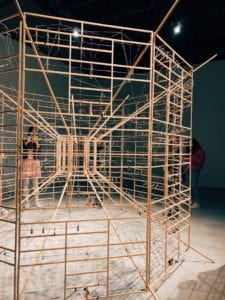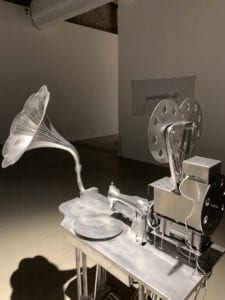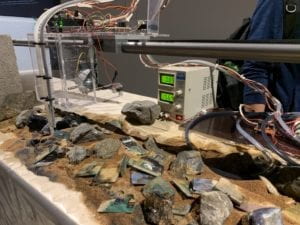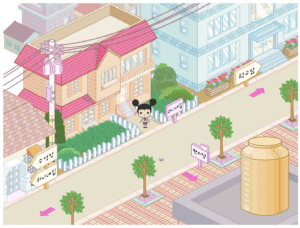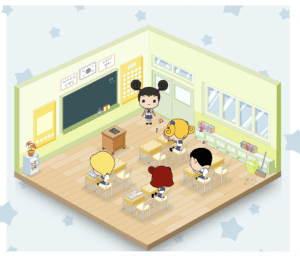During our field trip to the Chronus exhibition, I was fascinated by the combination of technology with art. Particularly, I really liked the Arduino and rock art because it was interesting to see how the Arduino that we use in class can be used in another medium – through still art. Since we usually utilize Arduino as a connector/processor, it was cool to see it in display alongside rocks, a natural resource. The juxtaposition between technology and nature intrigued me since it was a combination that I never realized before. Compared to other museums such as the MoMa, I think the concepts are similar in terms of modern art. However, other arts in galleries that I’ve been to, one being the Renwick Gallery in Washington D.C, I sense that a lot of the pieces there are very historical and involves still art or paintings. Most of the pieces in those galleries are not interactive. In addition, the interior design of those art galleries is very intricate and beautiful, involving many historical architecture and designs. Whereas the interior of the Chronus exhibition is rather simple and plain, allowing the audience to fully-focus on the art pieces and interact with them.
While I was researching about possible projects for the final project, I was scrolling through a website called the MarshallProject, which specializes in online journalism about criminal justice. In particular, there is one interactive web project that caught my eye, which is called “Banished”, about the difficult lives of Sex offenders after they are released from prison. In this web project, there are many elements that make it interactive, such as background music throughout the reading, videos, and photos in accordance with the different paragraphs, as well as the option to read more about other articles, or take action. This project reminded me of the interactive comic project that I did in my past Communications Lab class, where we also did a storytelling project through code and other content. Although I really like the publication and the different parts of the story that makes the article unique, I think that it is a lesser successful version of an interactive project, because users are limited to scrolling, clicking different buttons and going to other sites. Therefore, there is a limited amount of communication between the user and the computer, which is why I think it is a less interactive project overall. But, this project does give me inspiration about my own project, since I want to curate or tell a story through a medium similar to doing interviews and research, to tell a story.
Another project that I think is interesting is the Wooden Mirror Project by Daniel Rozin, in the NYU ITP program in New York City. The project itself entails a wall of wooden blocks that have cameras inserted as a part of the piece and rotates the wooden pieces as people walk by, which is detected by the cameras. As people walk by it and light bounces off, the overall shape changes, providing a unique experience for the user each time. For me, this project is a successful example of an interactive project because it embodies every part of my definition of interactivity, which means communication. As people walk by it, the camera detects the movements and produces a response that allows the users to engage and interact with it.

Lastly, there is this game that I used to play as a kid. It is called 大头妹的美妙人生, or Pangpang Games. Basically, it is a cute role-playing game revolving around the girl Pangpang, allowing users to control her actions to experience life. Users can go to school, hang out with friends at the pool, or go to a convenience store. Through the different buttons, users can explore different parts of the world and immerse themselves in it, living vicariously through the main character Pangpang. The reason why I researched about this project was that I had so much fun playing this game. I enjoyed playing the game a lot as a kid, and I was surprised to find out that, even after revisiting the game as an adult, my adoration for the game did not dimish. Partly because the game was very nostalgic and I had a bias towards it, but another part of me really enjoyed playing the game. Although the options to explore the world wasn’t limitless, I still had a lot of fun playing it, and that experience is continuous, which is an element that I think is a crucial part of interactivity: the addiction to the project, attracting the users to engage with the project over and over again.
My definition of interactivity is essentially communication, through input, processing, and output. In order to successfully interact with others, communication is key, as well as language. My definition also aligns with Igoe and O’Sullivan’s note about interaction, which includes input, output, and processing (Igoe and O’Sullivan). In order for the interaction to happen, there must be at least two parties present to allow for communication, or transfer of messages. Successful communication entails more than just speaking, but also the act of understanding. While communicating may seem easy, effective communication takes effort and time. Therefore, my definition of interactivity is about communication, and how the two parties can better understand each other through successful input, processing, and output to produce a result that both parties can understand and continue in conversation.
Based on my initial interpretation of interactivity and through creating my midterm project, my definition of what a successful interaction changed drastically, Whereas before, I thought that as long as there are the three components: input, processing, and output, there is an interaction between two parties. However, after doing research about different creative interactive projects, I think that a successful interactive experience is continuous and fun. Although my midterm project (Interactive Christmas Music Box) might be an interesting piece to play with, it is not interactive enough. Since there were only 3 buttons the users could press, the options are limited, and users are restricted to only one method of interaction, by pressing and buttons and looking at the lights while listening to the music. I think a successful interactive project should be one that is continuous, and allows users to play with or interact with over and over again, and get a different feeling each time. This is why I think the Pangpang game is a paradigm of a successful interaction project, as the game allows users to feel continuous attraction to play the game, and enjoy the experience. Although the Marshallproject offers many options for users to explore, I felt like it was a one-time visit type of project, since it was an article. I think that a more successful example would be similar to the Wooden Mirror Project, allowing users to gain a different experience each time when they walk past it. The project provides users with a continuous, fun experience and allows people to engage with the project more, trigger different reactions.
References
Pangpang Game: http://www.4399.com/flash/10098_2.htm
Igoe and O’Sullivan. “Introduction.” Introduction to Physical Computing.
NYU’S ITP Wooden Mirror: https://www.youtube.com/watch?v=Wb6eFGbwPeA
Banished: https://www.themarshallproject.org/2018/10/03/banished
